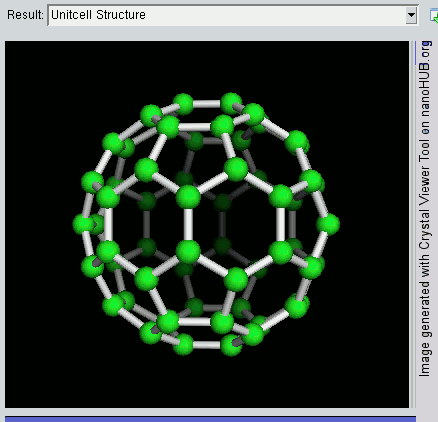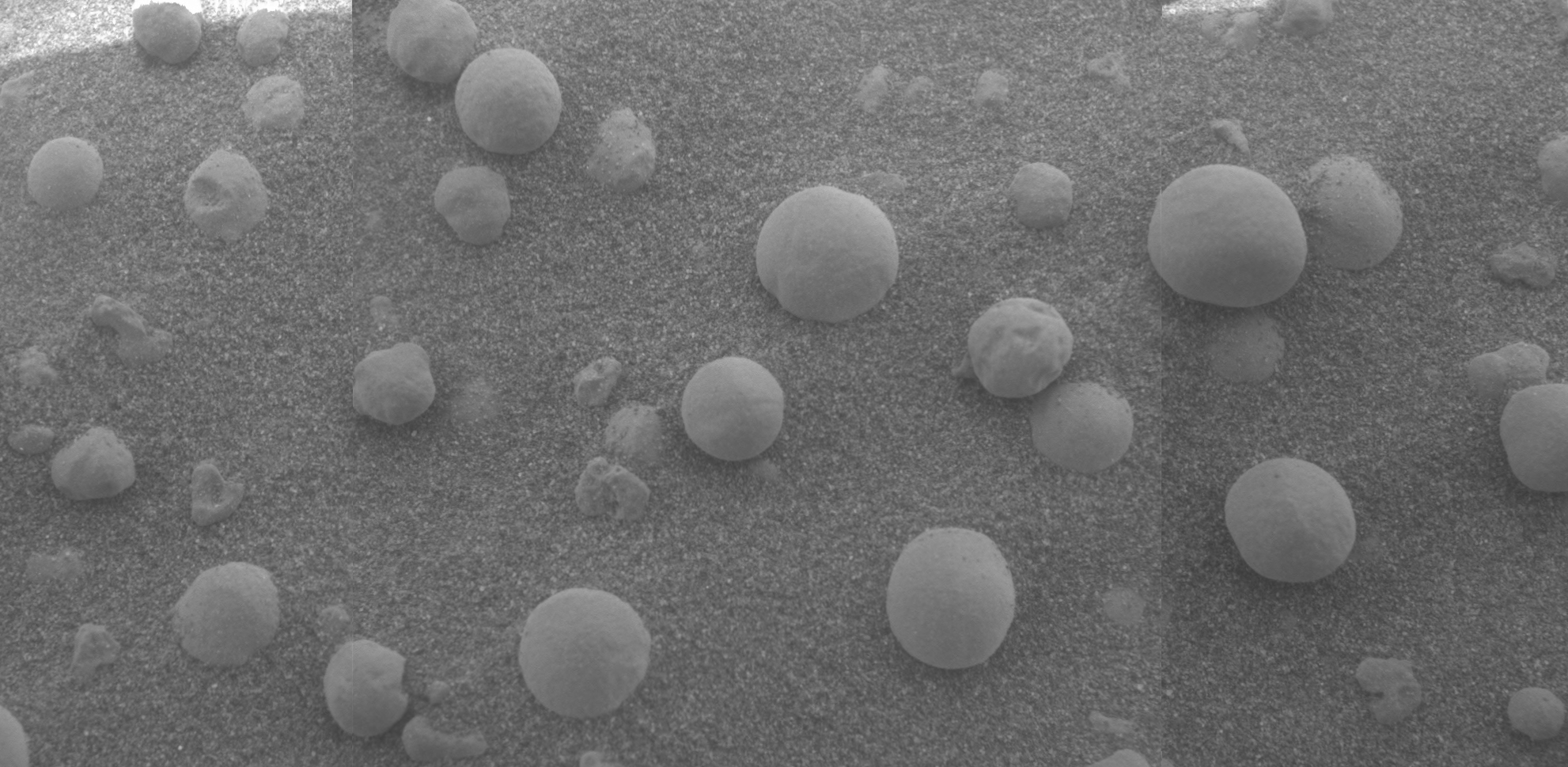|
Ferrihydrite
Ferrihydrite (Fh) is a widespread hydrous ferric oxyhydroxide mineral at the Earth's surface, and a likely constituent in extraterrestrial materials. It forms in several types of environments, from freshwater to marine systems, aquifers to hydrothermal hot springs and scales, soils, and areas affected by mining. It can be precipitated directly from oxygenated iron-rich aqueous solutions, or by bacteria either as a result of a metabolic activity or passive sorption of dissolved iron followed by nucleation reactions. Ferrihydrite also occurs in the core of the ferritin protein from many living organisms, for the purpose of intra-cellular iron storage. Structure Ferrihydrite only exists as a fine grained and highly defective nanomaterial. The powder X-ray diffraction pattern of Fh contains two scattering bands in its most disordered state, and a maximum of six strong lines in its most crystalline state. The principal difference between these two diffraction end-members, commonly nam ... [...More Info...] [...Related Items...] OR: [Wikipedia] [Google] [Baidu] |
Oxide Minerals
The oxide mineral class includes those minerals in which the oxide anion (O2−) is bonded to one or more metal alloys. The hydroxide-bearing minerals are typically included in the oxide class. Minerals with complex anion groups such as the Silicate mineral, silicates, Sulfate mineral, sulfates, carbonate mineral, carbonates and Phosphate mineral, phosphates are classed separately. Simple oxides *XO form **Periclase group ***Periclase ***Manganosite **Zincite group ***Zincite ***Bromellite ***Tenorite ***Litharge * form **Cuprite **Ice * form **Hematite group ***Corundum ***Hematite ***Ilmenite * form **Rutile group ***Rutile ***Pyrolusite ***Cassiterite **Baddeleyite **Uraninite **Thorianite * form **Spinel group ***Spinel ***Gahnite ***Magnetite ***Franklinite ***Chromite **Chrysoberyl **Columbite *Hydroxide subgroup: **Brucite **Manganite **Romanèchite **Goethite group: ***Diaspore ***Goethite Nickel–Strunz class 4: oxides Internationa ... [...More Info...] [...Related Items...] OR: [Wikipedia] [Google] [Baidu] |
Hydrous Ferric Oxides
Iron(III) oxide-hydroxide or ferric oxyhydroxideA. L. Mackay (1960): "β-Ferric Oxyhydroxide". ''Mineralogical Magazine'' (''Journal of the Mineralogical Society''), volume 32, issue 250, pages 545-557. is the chemical compound of iron, oxygen, and hydrogen with formula . The compound is often encountered as one of its hydrates, ·''n'' (rust). The monohydrate · is often referred to as iron(III) hydroxide , hydrated iron oxide, yellow iron oxide, or Pigment Yellow 42. Natural occurrences Minerals Anhydrous ferric hydroxide occurs in the nature as the exceedingly rare mineral bernalite, Fe(OH)3·''n''H2O (''n'' = 0.0–0.25). Iron oxyhydroxides, , are much more common and occur naturally as structurally different minerals (polymorphs) denoted by the Greek letters α, β, γ and δ. * Goethite, α-FeO(OH), has been used as an ochre pigment since prehistoric times. * Akaganeite is the β polymorph,A. L. Mackay (1962): "β-Ferric oxyhydroxide—akaganéite", ''Mineralogic ... [...More Info...] [...Related Items...] OR: [Wikipedia] [Google] [Baidu] |
Alain Manceau
Alain Manceau, born September 19, 1955, is a French environmental mineralogist and biogeochemist. He is known for his research on the structure and reactivity of nanoparticulate iron and manganese oxides and clay minerals, on the crystal chemistry of strategic metals and rare-earth elements, and on the structural biogeochemistry of mercury in natural systems, animals, and humans. Biography Manceau is a former pupil of the École Saint-Martin-de-France in Pontoise, then of the Lycée Henri IV in Paris where he completed his preparatory classes before entering the École Normale Supérieure de Saint-Cloud (now École Normale Supérieure de Lyon) in 1977. He obtained the agrégation in natural sciences in 1981, then his doctorate in 1984 at the University Paris VII (now Université Paris Cité) under the direction of George Calas. He spent his entire academic career at the French National Centre for Scientific Research (CNRS), first as a research fellow from 1984, then as a rese ... [...More Info...] [...Related Items...] OR: [Wikipedia] [Google] [Baidu] |
Aggregate (composite)
Aggregate is the component of a composite material that resists compressive stress and provides bulk to the material. For efficient filling, aggregate should be much smaller than the finished item, but have a wide variety of sizes. Aggregates are generally added to lower the amount of binders needed and to increase the strength of composite materials. Sand and gravel are used as construction aggregate with cement to make concrete and increase its mechanical strength. Aggregates make up 60-80% of the volume of concrete and 70-85% of the mass of concrete. Comparison to fiber composites ''Aggregate composites'' are easier to fabricate, and more predictable in their finished properties, than '' fiber composites''. Fiber orientation and continuity can have a large effect, but can be difficult to control and assess. Aggregate materials are generally less expensive. Mineral aggregates are found in nature and can often be used with minimal processing. Not all composite materials i ... [...More Info...] [...Related Items...] OR: [Wikipedia] [Google] [Baidu] |
Nanomaterial
Nanomaterials describe, in principle, chemical substances or materials of which a single unit is sized (in at least one dimension) between 1 and 100 nm (the usual definition of nanoscale). Nanomaterials research takes a materials science-based approach to nanotechnology, leveraging advances in materials metrology and synthesis which have been developed in support of microfabrication research. Materials with structure at the nanoscale often have unique optical, electronic, thermo-physical or mechanical properties. Nanomaterials are slowly becoming commercialized and beginning to emerge as commodities. Definition In ISO/TS 80004, ''nanomaterial'' is defined as the "material with any external dimension in the nanoscale or having internal structure or surface structure in the nanoscale", with ''nanoscale'' defined as the "length range approximately from 1 nm to 100 nm". This includes both ''nano-objects'', which are discrete pieces of material, and ''nanostructur ... [...More Info...] [...Related Items...] OR: [Wikipedia] [Google] [Baidu] |
Akdalaite
Akdalaite (IMA symbol: Akd) is a very rare mineral found in Kazakhstan and has the formula . It was formerly believed to be . It is therefore the same as tohdite an artificially produced phase. Studies on the crystal structure and spectra indicate that this is an aluminium oxide hydroxide.Ab-initio quantum mechanical study of akdalaite (5Al2O3· H2O): structure and vibrational spectrum, Demichelis, R.; Noel, Y.; Zicovich-Wilson, C. M.; Roetti, C.; Valenzano, L.; Dovesi, R., Journal of Physics: Conference Series, Volume 117, Issue 1, pp. 012013 (2008)., References External links Fact sheetfrom mindat.org Mindat.org is a non-commercial interactive online database covering minerals around the world. Originally created by Jolyon Ralph as a private project in 1993, it was launched as a community-editable website in October 2000. it is operated by ... Fact sheetfrowebmineral.com Aluminium minerals Oxide minerals Monohydrate minerals Hexagonal minerals Minerals describe ... [...More Info...] [...Related Items...] OR: [Wikipedia] [Google] [Baidu] |
Pair Distribution Function
The pair distribution function describes the distribution of distances between pairs of particles contained within a given volume. Mathematically, if ''a'' and ''b'' are two particles, the pair distribution function of ''b'' with respect to ''a'', denoted by g_(\vec) is the probability of finding the particle ''b'' at distance \vec from ''a'', with ''a'' taken as the origin of coordinates. Overview The pair distribution function is used to describe the distribution of objects within a medium (for example, oranges in a crate or nitrogen molecules in a gas cylinder). If the medium is homogeneous (i.e. every spatial location has identical properties), then there is an equal probability density for finding an object at any position \vec: :p(\vec)=1/V, where V is the volume of the container. On the other hand, the likelihood of finding ''pairs of objects'' at given positions (i.e. the two-body probability density) is not uniform. For example, pairs of hard balls must be separated by ... [...More Info...] [...Related Items...] OR: [Wikipedia] [Google] [Baidu] |
High-resolution Transmission Electron Microscopy
High-resolution transmission electron microscopy is an imaging mode of specialized transmission electron microscopes that allows for direct imaging of the atomic structure of samples. It is a powerful tool to study properties of materials on the atomic scale, such as semiconductors, metals, nanoparticles and sp2-bonded carbon (e.g., graphene, C nanotubes). While this term is often also used to refer to high resolution scanning transmission electron microscopy, mostly in high angle annular dark field mode, this article describes mainly the imaging of an object by recording the two-dimensional spatial wave amplitude distribution in the image plane, similar to a "classic" light microscope. For disambiguation, the technique is also often referred to as phase contrast transmission electron microscopy, although this term is less appropriate. At present, the highest point resolution realised in high resolution transmission electron microscopy is around . At these small scales, individual ... [...More Info...] [...Related Items...] OR: [Wikipedia] [Google] [Baidu] |
Neutron Diffraction
Neutron diffraction or elastic neutron scattering is the application of neutron scattering to the determination of the atomic and/or magnetic structure of a material. A sample to be examined is placed in a beam of Neutron temperature, thermal or cold neutron radiation, neutrons to obtain a diffraction pattern that provides information of the structure of the material. The technique is similar to X-ray diffraction but due to their different scattering properties, neutrons and X-rays provide complementary information: X-Rays are suited for superficial analysis, strong x-rays from synchrotron radiation are suited for shallow depths or thin specimens, while neutrons having high penetration depth are suited for bulk samples.Measurement of residual stress in materials using neutrons IAEA, ... [...More Info...] [...Related Items...] OR: [Wikipedia] [Google] [Baidu] |
Hematite
Hematite (), also spelled as haematite, is a common iron oxide compound with the formula, Fe2O3 and is widely found in rocks and soils. Hematite crystals belong to the rhombohedral lattice system which is designated the alpha polymorph of . It has the same crystal structure as corundum () and ilmenite (). With this it forms a complete solid solution at temperatures above . Hematite occurs naturally in black to steel or silver-gray, brown to reddish-brown, or red colors. It is mined as an important ore mineral of iron. It is electrically conductive. Hematite varieties include ''kidney ore'', ''martite'' ( pseudomorphs after magnetite), ''iron rose'' and ''specularite'' ( specular hematite). While these forms vary, they all have a rust-red streak. Hematite is not only harder than pure iron, but also much more brittle. The term ''kidney ore'' may be broadly used to describe botryoidal, mammillary, or reniform hematite. Maghemite is a polymorph of hematite (γ-) with the ... [...More Info...] [...Related Items...] OR: [Wikipedia] [Google] [Baidu] |
Feroxyhyte
Feroxyhyte is an oxide/hydroxide of iron, δ-Fe3+O(OH). Feroxyhyte crystallizes in the hexagonal system. It forms as brown rounded to concretionary masses. Feroxyhyte is opaque, magnetic, has a yellow streak, and has a relative density of 4.2. It occurs in manganese-iron nodules on the Atlantic and Pacific Ocean floors. It is also found in the Baltic, White, and Kara Seas. Forms under high pressure conditions and reverts to goethite on exposure to surface conditions. It also occurs as cement and coatings on clasts in poorly drained soils and sediments, formed by the rapid oxidation of iron(II) oxide compounds. It was first described in 1976 for an occurrence in soils at its type locality: Kolomyya, Ivano-Frankivsk Oblast, Ukraine Ukraine is a country in Eastern Europe. It is the List of European countries by area, second-largest country in Europe after Russia, which Russia–Ukraine border, borders it to the east and northeast. Ukraine also borders Belarus to the n ... [...More Info...] [...Related Items...] OR: [Wikipedia] [Google] [Baidu] |




